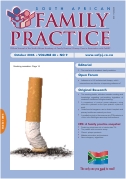Adherence To HIV Antiretroviral Therapy Part II: Which Interventions Are Effective In Improving Adherence?
Abstract
Interventions to support adherence to antiretroviral therapy (ART) can be classified into four categories: cognitive, beha-vioural and affective interventions and (modified) directly observed therapy (DOT.) Cognitive interventions improve HIV- and ART-related knowledge, but this is not consistently associated with better adhe-rence. Cognitive interventions that are combined with behavioural or psychological strategies are more effective in improving adherence, especially in patients who previously were less adherent. These include interventions that improve self-efficacy, provide stress management/expressive support therapy or motivational interviewing. As yet there is no evidence for the role of affective interventions and modified DOT to improve adherence to ART. When designing interventions to address adherence, it should be borne in mind that multi-component interventions are more effective than single-focus interventions. A combination of educational, behavioural and affective components is suggested to ensure optimum adherence. In countries with a high prevalence of HIV, such as South Africa, careful patient preparation, rather than selecting patients based on non-clinical predictors of adherence, seems an appropriate method for scaling up ART. South African guidelines focus on comprehensive adherence support to all patients, with additional support to patients with less than 80% adherence. More research on the effectiveness of interventions aimed at improving adherence is urgently needed, especially in develo-ping countries. SA Fam Pract 2006;48(9): 6-10)
Section
Forum
By submitting manuscripts to SAFP, authors of original articles are assigning copyright to the South African Academy of Family Physicians. Copyright of review articles are assigned to the Publisher, Medpharm Publications (Pty) Ltd, unless otherwise specified. Authors may use their own work after publication without written permission, provided they acknowledge the original source. Individuals and academic institutions may freely copy and distribute articles published in SAFP for educational and research purposes without obtaining permission.

